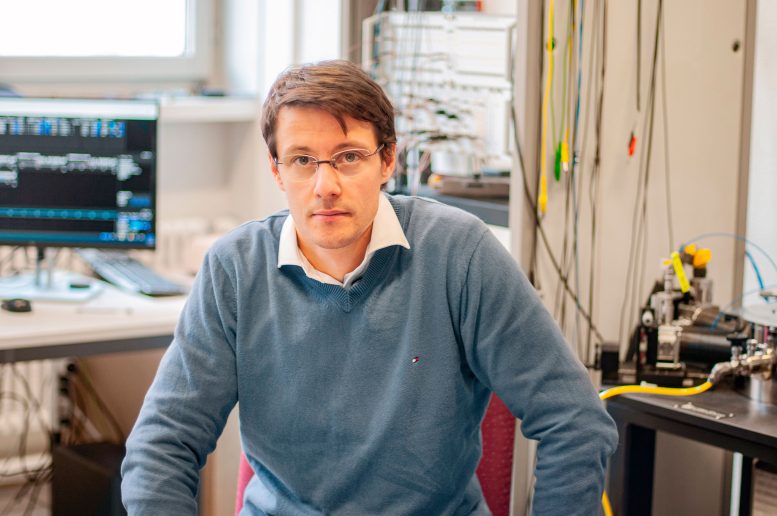 Mickael Perrin, a quantum physicist, is using graphene ribbons to create nanoscale power plants that can convert waste heat from electrical equipment into electricity.
Mickael Perrin, a quantum physicist, is using graphene ribbons to create nanoscale power plants that can convert waste heat from electrical equipment into electricity.
When Mickael Perrin began his scientific career 12 years ago, little did he know that he would be conducting research in a field that would gain significant public interest in the years to come: quantum electronics. “At the time, physicists were just starting to discuss the potential of quantum technologies and quantum computers,” he recalls. “Today, there are numerous start-ups in this field, and substantial investments are being made by governments and companies to further develop the technology, with the first applications emerging in computer science, cryptography, communications, and sensors.”Perrin’s research is paving the way for another area of application: electricity generation using quantum effects with minimal energy loss. To achieve this, the 36-year-old scientist combines two usually distinct disciplines of physics: thermodynamics and quantum mechanics. Mickael Perrin. Credit: SNFRecognizing ExcellenceIn the past year, Perrin’s outstanding research and its potential for future applications have earned him two awards: he has received one of the highly sought-after ERC Starting Grants for young researchers, as well as an Eccellenza Professorial Fellowship from the Swiss National Science Foundation (SNS)F. He now leads a research group of nine at Empa and is an Assistant Professor of Quantum Electronics at ETH Zurich.A Journey Through PhysicsPerrin admits that he never considered himself naturally gifted in mathematics. “It was primarily my curiosity that led me to physics. I wanted to understand how the world around us functions, and physics offers excellent tools for achieving that,” he says. After completing high school in Amsterdam, he pursued a degree in applied physics at Delft University of Technology (TU Delft) in 2005. From the outset, Perrin was more interested in practical applications than theory.It was during his studies under Herre van der Zant, a pioneer in the field of quantum electronics, that Perrin first encountered the excitement of engineering tiny devices at the microscale and nanoscale. He soon recognized the unlimited possibilities presented by molecular electronics, as circuits exhibit entirely different characteristics based on the selected molecules and materials, and can serve as transistors, diodes, or sensors.The Challenge of Nanoscale EngineeringWhile pursuing his doctorate, Perrin spent a significant amount of time in the nanolab cleanroom at TU Delft – constantly donning a white full-body suit to prevent contamination of the miniature electronics by hairs or dust particles. The cleanroom provided the necessary technological infrastructure for constructing machines just a few nanometres in size (about 10,000 times smaller than the diameter of a human hair).”As a general rule, the smaller the structure you want to build, the larger and more expensive the machine you will need to do so,” explains Perrin. For instance, lithography machines are utilized to pattern complex mini-circuits on microchips. “Nanofabrication and experimental physics demand a great deal of creativity and patience, as things almost always go awry,” says Perrin. “However, it is often the unusual and unexpected results that prove to be the most exciting.”Graphene – A Miracle MaterialA year after completing his doctorate, Perrin secured a position at Empa in the laboratory of Michel Calame, an expert in integrating quantum materials into nano devices. Since then, Perrin – a French and Swiss national – has resided in Dübendorf with his partner and two daughters.”Switzerland was the right choice for me for several reasons,” he states. “The research infrastructure is unparalleled.” Empa, ETH Zurich, and the IBM Research Center in Rüschlikon provide him with the essential resources for producing nanostructures, as well as the measuring instruments for testing them.”Moreover, I am an outdoors person. I cherish the mountains and frequently engage in hiking and skiing with my family.” Perrin is also an avid rock climber. He occasionally embarks on climbing expeditions in remote valleys for several weeks at a time, often in France, which is his family’s native country.At Empa, this young researcher had the freedom to continue experimenting with nanomaterials. A particular material soon captured his attention: graphene nanoribbons, a material composed of carbon atoms as thin as individual atoms. These nanoribbons are manufactured with exceptional precision by Roman Fasel’s group at Empa. Perrin demonstrated that these ribbons possess unique properties and can be utilized for various quantum technologies.Simultaneously, he became deeply interested in converting heat into electrical energy. In 2018, it was demonstrated that quantum effects can be effectively employed to convert thermal energy into electricity. Until now, the obstacle has been that these desirable physical properties are only evident at very low temperatures – close to absolute zero (0 Kelvin; -273°C). This has little relevance to potential future applications such as in smartphones or minisensors. Perrin conceived of circumventing this issue by using graphene nanoribbons. The specific physical properties of these nanoribbons mean that temperature exerts a much smaller influence on the quantum effects – and consequently the desired thermoelectric effects – compared to other materials.His group at Empa soon showed that the quantum effects of graphene nanoribbons are largely preserved even at 250 Kelvin, equivalent to -23°C. The system is expected to operate at room temperature in the future.Future Challenges and AmbitionsSeveral challenges must be overcome before the technology can lead to reduced power consumption in smartphones. The extreme miniaturization necessitates the continual use of special components to ensure the functionality of the constructed systems.Perrin, along with colleagues from China, the UK, and Switzerland, recently demonstrated that carbon nanotubes measuring just one nanometre in diameter can be integrated into those systems as electrodes. However, Perrin estimates that it will take at least another 15 years before these delicate and highly intricate materials can be manufactured on a large scale and incorporated into devices.”My goal is to establish the fundamental basis for applying this technology. Only then will we be able to assess its potential for practical uses.”
Mickael Perrin. Credit: SNFRecognizing ExcellenceIn the past year, Perrin’s outstanding research and its potential for future applications have earned him two awards: he has received one of the highly sought-after ERC Starting Grants for young researchers, as well as an Eccellenza Professorial Fellowship from the Swiss National Science Foundation (SNS)F. He now leads a research group of nine at Empa and is an Assistant Professor of Quantum Electronics at ETH Zurich.A Journey Through PhysicsPerrin admits that he never considered himself naturally gifted in mathematics. “It was primarily my curiosity that led me to physics. I wanted to understand how the world around us functions, and physics offers excellent tools for achieving that,” he says. After completing high school in Amsterdam, he pursued a degree in applied physics at Delft University of Technology (TU Delft) in 2005. From the outset, Perrin was more interested in practical applications than theory.It was during his studies under Herre van der Zant, a pioneer in the field of quantum electronics, that Perrin first encountered the excitement of engineering tiny devices at the microscale and nanoscale. He soon recognized the unlimited possibilities presented by molecular electronics, as circuits exhibit entirely different characteristics based on the selected molecules and materials, and can serve as transistors, diodes, or sensors.The Challenge of Nanoscale EngineeringWhile pursuing his doctorate, Perrin spent a significant amount of time in the nanolab cleanroom at TU Delft – constantly donning a white full-body suit to prevent contamination of the miniature electronics by hairs or dust particles. The cleanroom provided the necessary technological infrastructure for constructing machines just a few nanometres in size (about 10,000 times smaller than the diameter of a human hair).”As a general rule, the smaller the structure you want to build, the larger and more expensive the machine you will need to do so,” explains Perrin. For instance, lithography machines are utilized to pattern complex mini-circuits on microchips. “Nanofabrication and experimental physics demand a great deal of creativity and patience, as things almost always go awry,” says Perrin. “However, it is often the unusual and unexpected results that prove to be the most exciting.”Graphene – A Miracle MaterialA year after completing his doctorate, Perrin secured a position at Empa in the laboratory of Michel Calame, an expert in integrating quantum materials into nano devices. Since then, Perrin – a French and Swiss national – has resided in Dübendorf with his partner and two daughters.”Switzerland was the right choice for me for several reasons,” he states. “The research infrastructure is unparalleled.” Empa, ETH Zurich, and the IBM Research Center in Rüschlikon provide him with the essential resources for producing nanostructures, as well as the measuring instruments for testing them.”Moreover, I am an outdoors person. I cherish the mountains and frequently engage in hiking and skiing with my family.” Perrin is also an avid rock climber. He occasionally embarks on climbing expeditions in remote valleys for several weeks at a time, often in France, which is his family’s native country.At Empa, this young researcher had the freedom to continue experimenting with nanomaterials. A particular material soon captured his attention: graphene nanoribbons, a material composed of carbon atoms as thin as individual atoms. These nanoribbons are manufactured with exceptional precision by Roman Fasel’s group at Empa. Perrin demonstrated that these ribbons possess unique properties and can be utilized for various quantum technologies.Simultaneously, he became deeply interested in converting heat into electrical energy. In 2018, it was demonstrated that quantum effects can be effectively employed to convert thermal energy into electricity. Until now, the obstacle has been that these desirable physical properties are only evident at very low temperatures – close to absolute zero (0 Kelvin; -273°C). This has little relevance to potential future applications such as in smartphones or minisensors. Perrin conceived of circumventing this issue by using graphene nanoribbons. The specific physical properties of these nanoribbons mean that temperature exerts a much smaller influence on the quantum effects – and consequently the desired thermoelectric effects – compared to other materials.His group at Empa soon showed that the quantum effects of graphene nanoribbons are largely preserved even at 250 Kelvin, equivalent to -23°C. The system is expected to operate at room temperature in the future.Future Challenges and AmbitionsSeveral challenges must be overcome before the technology can lead to reduced power consumption in smartphones. The extreme miniaturization necessitates the continual use of special components to ensure the functionality of the constructed systems.Perrin, along with colleagues from China, the UK, and Switzerland, recently demonstrated that carbon nanotubes measuring just one nanometre in diameter can be integrated into those systems as electrodes. However, Perrin estimates that it will take at least another 15 years before these delicate and highly intricate materials can be manufactured on a large scale and incorporated into devices.”My goal is to establish the fundamental basis for applying this technology. Only then will we be able to assess its potential for practical uses.”
Nanoscale Power Plants: Converting Heat Into Power Using Graphene Ribbons














